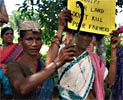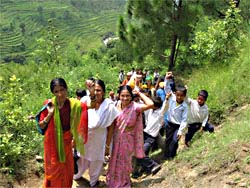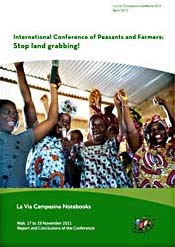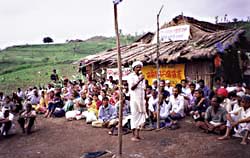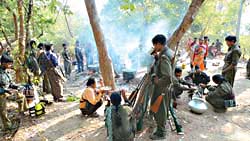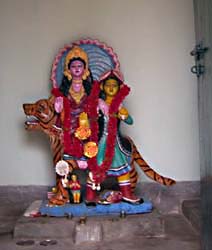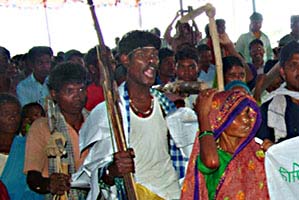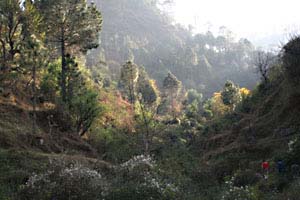ISSUES
The Powerful Combination
Building Up and Criticizing at the Same Time
What is the best way to revitalise the rural areas? Is it by development projects like planting trees, building
water harvesting structures or starting a small factory to process medical herbs? Or is it by campaigning against
a corrupt Forest Department and government? Both constructive work and
campaigning have to be done. At the same time. Constructive work without changing the system is useless, because
the system will destroy the livelihood of the people faster than we can build up. But campaigning without constructive
work can easily become sterile. Even when the slogans hit the nail on the head, people cannot eat slogans. But the
combination of building up village economy with campaigns to protect the rights of the villagers is powerful.
Read more
Map
_______________________
Via Campesina
a Global Peasant Movement
Via Campesina is a global peasants' movement fighting for food sovereignty. It published a lot of booklets about all political issues relating to peasants. For example: 'Stop Land Grabbing', 'Peasants Can Feed the World', 'No To Violence Against Women' and 'Small Scale Farmers Are Cooling Down the Earth'. Read more
_______________________
Sitting on the Fence
Letter from a Middle Class Activist
It is a terrible idea that we, middle class activists, sit at the fence, when 'our people', the small farmers, are killed by the government. Killed by decades old exploitation, by displacement for mining and so many other projects and now killed as collateral damage for hunting the 'Maoists'. At the same time we are sitting on the fence, doing almost nothing. Traveling, having some discussions, writing an article, making a picture, compiling a website. Read more Print Nederlands Druk af
_______________________
India's Anti-Displacement Movements
David Pugh
I traveled across five states in central and eastern India visiting the sites of proposed industrial and mining projects, Special Economic Zones and real estate developments. I spoke with hundreds of villagers who are threatened with displacement and with many dedicated activists who are helping to organize the people's resistance. Read more Map
_______________________
Heavy Resistance Adivasis Against Globalisation
Photo article
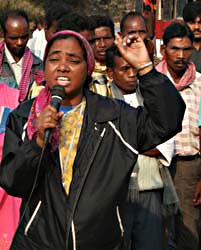 Bahan Bulu, an experienced Adivasi activist, gives a speech.
Bahan Bulu, an experienced Adivasi activist, gives a speech.
The economy of India grows incredibly fast the last years. Even in our times of worldwide financial and economic crisis it still
goes strong, be it a little less. Still there are some drawbacks. Big companies got much more freedom to do what they want. They displace
small scale farmers and even expel Adivasis, the original peoples of India, from the regions protected earlier. But the resistance grows
from day to day. The farmers realize they will lose everything when their land has gone. Our reporter visited villages
in all quarters of the vast country.
Read more Print
Nederlands Druk af
Map
_______________________
 This 'enclave' consists of about thousand apartments with a car-park under the buildings, a swimming pool, tennis courts and a club house 'for members only'. Big fences and
security guards all around.
This 'enclave' consists of about thousand apartments with a car-park under the buildings, a swimming pool, tennis courts and a club house 'for members only'. Big fences and
security guards all around.
Islands of Wealth
gated communities
All big cities in India have 'enclaves' or 'gated communities'. This are well protected islands of luxury for the well-to-do middle class people who
have the better paid jobs at the companies and the government. The people who are the
profiteers of the very unjust social-economic structure which is the cause of the poverty, the exploitation
and the richness.
More photos Map
_______________________
Reflections on Violence and Non-Violence
in Political Movements in India
K Balagopal
The public arena is witness to dispirited discussion of the ineffectiveness of people's movements, which are at the most able to slow down things, and nothing more. The discussion often turns around violence and non-violence, not as moral alternatives but as strategic options. Those who are sick of sitting on dharna after dharna to no effect are looking with some envy at violent options, while many who have come out of armed groups find the Narmada Bachao Andolan fascinating (organisation of non-violent groups fighting against the Narmada dam). Read more Print
_______________________
Arundhati Roy about Narmada dam
'Who owns this land? Who owns its rivers? Its forests?'
The famous Indian writer and journalist Arundathi Roy wrote a long article for Outlook magazine about the Narmada Dam Project in the West of India. She
also discuses the question how useful big projects are. Who are the winners, who the losers and who are resisting.
"In India over the last ten years the fight against the Sardar Sarovar Dam has come to represent far more than the fight for one river. (..) It became
a debate that captured the popular imagination. (..) From being a fight over the fate of a river valley it began to raise doubts about an entire
political system. What is at issue now is the very nature of our democracy. Who owns this land? Who owns its rivers? Its forests? Its fish?"
Go to the introduction article or download the whole article (in Word, 400 KB)
_______________________
Arundhati Roy With the Guerillas
roaming around in the forest for several weeks
Arundhati Roy traveled around with the Maoists in the center Indian state Chhattisgarh for
several weeks. The guerillas are mostly young tribals (women and men) fighting against oppression and displacement for dams and mines and
for their autonomy as small farmers with their own local culture.
Roy: "The antagonists in the forest (of the government and companies) are disparate and unequal in almost every way. On one side is a massive
paramilitary force armed with the money, the firepower, the media, and the hubris of an emerging Superpower. On the other, ordinary villagers
armed with traditional weapons, backed by a
superbly organised, hugely motivated Maoist guerrilla fighting force with an extraordinary and violent history of armed rebellion."
Go to the introduction article or download the whole article (in Word, 1.5 MB)
_______________________
Bon Bibi Legend and 'Ethnic Cleansing' of India's Forests
Amitav Ghosh
Indian writer Amitav Ghosh is very angry about the Indian forest policy: "Over many decades, there has been a kind of 'ethnic cleansing' of India's
forests: indigenous groups have been evicted or marginalised and hotel chains and urban tourists have moved in." With the help of the beautiful Bon
Bibi legend from the Bengal mangrove forests Ghosh describes the relationship between the villagers and their forests. He warns the political
disempowerment of the forest dwellers will not
continue forever. Read more Map
Download full article from Amitav Ghosh: 'Wild Fictions', 7 pages in Word, 7 photos; 400 KB.
_______________________
Mother Earth - New Future for Small Farmers
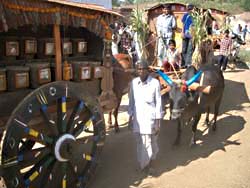 A parade of bullock carts travells from village to village, to celebrate the richness of the traditional seeds.
A parade of bullock carts travells from village to village, to celebrate the richness of the traditional seeds.
Documentary about poor women farmers in the South of India who turned their back to modern agriculture in order to bring new life to their traditional ways of farming. With a lot of success! Read more; link to the documentary
_______________________
Himalayan Waters
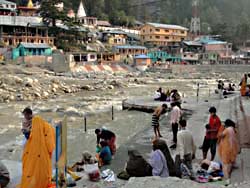 The life of Himalayan is closely linked with the rivers.
The life of Himalayan is closely linked with the rivers.
This documentary gives a quick overview of the water problems in the Himalayas. It also shows how villagers and their local organizations struggle against hydro power projects and deforestation and for safe drinking water; to protect their life and save the Himalayas. Read more; link to the documentary
_______________________
Damming the North East
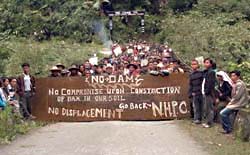 Idu Mishmi tribals oppose fake public hearing, March 2008.
Idu Mishmi tribals oppose fake public hearing, March 2008.
No fewer than 168 big dams in the North East of India will be constructed in the coming decades. That is what
the central Indian government, the banks and contractors have in mind.
But the resistance is growing. Lepchas and
Idu Mishmis tribals in Sikkim protest and in Assam there is a major political debate on the downstream impacts of dams.
Read more or download the full report (pdf,
1400 KB). map
_______________________
Dam Building in the Himalayas
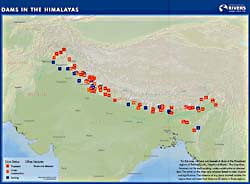 Many big dams are build already in the Himalayas, many more are planned.
Many big dams are build already in the Himalayas, many more are planned.
When you want a quick overview about the several hundred dam projects in the Himalayas for the next twenty years, you will find a
lot of information in the report Mountains of Concrete - dam building in the Himalayas.
Read more or download the full report (pdf,
2900 KB). map
Photos: Himcon, Uttarakhand; Arundhati Roy Outlook; Paul Enkelaar; HPSS, Uttarkashi, Uttarakhand and Peasant Autonomy - Creative Commons
